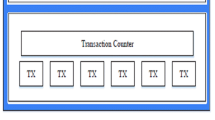Abstract
The traditional FOO e-voting protocols adopt centralized and non-transparent count center, which leads to distrust to the center and doubts the fairness and correctness of the vote. However, blockchain is the most innovative technology in the current era and promises to solve the trust problem in the system with one center. In this paper, an improved FOO e-voting protocol is proposed using blockchain, which tries to address the limitation or weakness in existing systems. The traditional trusted third party is replaced by smart contract; specifically, our scheme is deployed using hyperledger fabric. The implementation is enforced by the consensus mechanism, which ensures the security of the blockchain. Through the analysis, the proposed scheme is proved to satisfy the necessary requirements for an e-voting protocol; meantime the trust assumption is reduced significantly. Therefore, the proposed protocol is more versatile and practical.


Similar content being viewed by others
References
Song, J., Liu, Y., Shao, J., Tang, C.: A dynamic membership data aggregation (DMDA) protocol for smart grid. IEEE Syst. J. (2019). https://doi.org/10.1109/JSYST.2019.2912415
Liu, Y., Wang, Y., Wang, X., Xia, Z., Xu, J.: Privacy-preserving raw data collection without a trusted authority for IoT. Comput. Netw. 148, 340–348 (2019). https://doi.org/10.1016/j.comnet.2018.11.028
Chen, X., Wu, Q., Zhang, F., Tian, H., Wei, B., Lee, B., Lee, H., Kim, K.: New receipt-free voting scheme using double-trapdoor commitment. Inf. Sci. 181(8), 1493–1502 (2011)
Joaquim, R., Ferreira, P., Ribeiro, C.: EVIV: an end-to-end verifiable Internet voting system. Comput. Secur. 32(5), 170–191 (2013)
Li, C.T., Hwang, M.S., Liu, C.Y.: An electronic voting protocol with deniable authentication for mobile ad hoc networks. Comput. Commun. 31(10), 2534–2540 (2008)
Sebe, F., Miret, J.M., Pujol a s, J., Puiggali, J.: Simple and efficient hash-based verifiable mixing for remote electronic voting. Comput. Commun. 33(6), 667–675 (2010)
Chung, Y.F., Wu, Z.Y.: Casting ballots over internet connection against bribery and coercion. Comput. J. 55(10), 1169–1179 (2012)
Liu, Y., Zhao, Q.: E-Voting Scheme Using Secret Sharing and K-Anonymity. World Wide Web. https://doi.org/10.1007/s11280-018-0575-0 (2018). Accessed 17 Apr 2018
Chaum, D.L.: Untraceable electronic mail, return addresses, and digital pseudonyms. Commun. ACM 24(2), 84–90 (1981)
Cohen, J.D., Fischer, M.J.: A Robust and Verifiable Cryptographically Secure Election Scheme. New Haven, Department of Computer Science, Yale University (1985)
Lin, I.C., Hwang, M.S., Chang, C.C.: Security enhancement for anonymous secure e-voting over a network. Comput. Stand. Interfaces 25(2), 131–139 (2003)
Sun, S.F., Au, M.H., Liu, J.K., Yuen, T.H.: RingCT 2.0: a compact accumulator-based (linkable ring signature) protocol for blockchain cryptocurrency monero. In: Foley, S., Gollmann, D., Snekkenes, E. (eds.) ESORICS. LNCS, vol. 10493. Springer, Cham (2017). https://doi.org/10.1007/978-3-319-66399-9_25
Lu, R.X., Cao, Z.F., Zhou, Y.: Proxy blind multi-signature scheme without a secure channel. Appl. Math. Comput. 164(1), 179–187 (2015)
Fujioka, A., Okamoto, T., Ohta, K.: A practical secret voting scheme for large scale elections. In: Seberry, J., Zheng, Y. (eds.) AUSCRYPT. LNCS, vol. 718, pp. 244–251. Springer, Berlin (1992). https://doi.org/10.1007/3-540-57220-1_66
Joaquim, R., Zu quete, A., Ferreira, P.: REVS- a robust electronic voting system. IADIS Int. J. WWW/Internet 1(2), 47–63 (2003)
Cranor, L.F., Cytron, R.K.: Sensus: A security-conscious electronic polling system for the internet. In: Proceedings of the Thirtieth Hawaii International Conference on System Sciences, vol. 3, pp. 561–570. IEEE (1997). https://doi.org/10.1109/HICSS.1997.661700
Ohkubo, M., Miura, F., Abe, M., Fujioka, A., Okamoto, T.: An improvement on a practical secret voting scheme. In: Information Security. ISW 1999. LNCS, vol. 1729, pp. 225–234. Springer, Berlin (1999). https://doi.org/10.1007/3-540-47790-X_19
Chen, X.F., Wang, J.L., Wang, Y.: Receipt-free electronic voting based on semi-trusted model. J. Comput. 26(5), 557–662 (2003)
Nguyen, T.A.T., Dang, T.K.: Enhanced security in internet voting protocol using blind signature and dynamic ballots. Electron. Commer. Res. 13(3), 257–272 (2013)
Darwish, A., Gendy, M.M.E.: A new cryptographic voting verifiable scheme for e-voting system based on bit commitment and blind signature. Int. J. Swarm Intel. Evol. Comput. 6, 158 (2017). https://doi.org/10.4172/2090-4908.1000158
Moran, T., Naor, M.: Receipt-free universally-verifiable voting with everlasting privacy. In: Dwork, C. (ed.) CRYPTO 2006. LNCS, vol. 4117, pp. 373–392. Springer, Berlin (2006). https://doi.org/10.1007/11818175_22
Chaum, D.: Demonstrating that a public predicate can be satisfied without revealing any information about how. In: Odlyzko, A.M. (ed.) CRYPTO 1986. LNCS, vol. 263, pp. 195–199. Springer, Berlin (1987)
Boldyreva, A.: Threshold signatures, multi-signatures and blind signatures based on the Gap-Diffie-Hellman-Group signature scheme. In: Desmedt, Y.G. (ed.) PKC 2003. LNCS, vol. 2567, pp. 31–46. Springer, Berling (2003). https://doi.org/10.1007/3-540-36288-6_3
Juels, A., Luby, M., Ostrovsky, R.: Security of blind digital signatures. In: Kaliski, B.S. (ed.) CRYPTO 1997. LNCS, vol. 1294, pp. 150–164. Springer, Berlin (1997). https://doi.org/10.1007/BFb0052233
Kiayias, A., Zhou, H.: Equivocal blind signatures and adaptive UC-security. In: Canetti, R. (ed.) TCC 2008. LNCS, vol. 4948, pp. 340–355. Springer, Berlin (2008). https://doi.org/10.1007/978-3-540-78524-8_19
Pointcheval, D., Stern, J.: Security arguments for digital signatures and blind signatures. J Cryptol. 13(3), 361–396 (2000)
Blum, M.: Coin flipping by telephone a protocol for solving impossible problems. ACM SIGACT News 15(1), 23–27 (1983)
Iansiti, M., Lakhani, K.R.: The truth about blockchain. Harv. Bus. Rev. 95(1), 118–127 (2017)
Ma, C., Kong, X., Lan, Q., et al.: The privacy protection mechanism of hyperledger fabric and its application in supply chain finance. J. Cybersecur. 2(1), 5 (2019). https://doi.org/10.1186/s42400-019-0022-2
Idelberger, F., Governatori, G., Riveret, R., Sartor, G.: Evaluation of logic-based smart contracts for blockchain systems. In: Alferes, J., Bertossi, L., Governatori, G., Fodor, P., Roman, D. (eds.) Rule Technologies. Research, Tools, and Applications. RuleML 2016. LNCS, vol. 9718, pp. 167–183. Springer, Cham (2016)
Funding
This study was funded by National Natural Science Foundation of China (61662016,61702341) and Key projects of Guangxi Natural Science Foundation (2018JJD170004) and Innovation Project of GUET Graduate (2017YJCX49) and Innovation Project of Guangxi Graduate (YCSW2017139.) and GUET Excellent Graduate Thesis Program (16YJPYSS14).
Author information
Authors and Affiliations
Corresponding authors
Ethics declarations
Ethical approval
This article does not contain any studies with human participants or animals performed by any of the authors.
Additional information
Publisher's Note
Springer Nature remains neutral with regard to jurisdictional claims in published maps and institutional affiliations.
Rights and permissions
About this article
Cite this article
Zhou, Y., Liu, Y., Jiang, C. et al. An improved FOO voting scheme using blockchain. Int. J. Inf. Secur. 19, 303–310 (2020). https://doi.org/10.1007/s10207-019-00457-8
Published:
Issue Date:
DOI: https://doi.org/10.1007/s10207-019-00457-8




